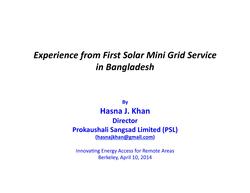Knowledge fuels change - Support energypedia!
For over 10 years, energypedia has been connecting energy experts around the world — helping them share knowledge, learn from each other, and accelerate the global energy transition.
Today, we ask for your support to keep this platform free and accessible to all.
Even a small contribution makes a big difference! If just 10–20% of our 60,000+ monthly visitors donated the equivalent of a cup of coffee — €5 — Energypedia would be fully funded for a whole year.
Is the knowledge you’ve gained through Energypedia this year worth €5 or more?
Your donation keeps the platform running, helps us create new knowledge products, and contributes directly to achieving SDG 7.
Thank you for your support, your donation, big or small, truly matters!
Experience from First Solar Mini Grid Service in Bangladesh
Experience from First Solar Mini Grid Service in Bangladesh
Presenter: Hasna. J. Khan, (Prokaushali Sangsad Limited, Bangladesh)
Overview
| A 100 kW solar minigrid service in the remote off-grid rural market of Sandwip island of Bangladesh has shown technical and commercial viability for the service provider. Financial planning of solar minigrid requires an optimum blend of consumer categories to ensure maximum socio-economic return on investment. Demand and supply side energy management is an important component of stable power supply from the solar minigrid. Policy-wise, subsidized financing with attractive incentives for the private service providers is essential at this early stage of solar minigrid deployment[1]. |
Main Topics Discussed
- • Fist solar mini grid in Bangldesh
- • Institutional design, what rural people need
- • Market area
- • Solar grids can replace diesel generators- 8000 markets out there
- • Road network all over country but small portion of rural network electrified.
- • Solar mini grids in Sandwip Island
- • Not accessible during some months due to Hymalaya water
- • Many natural disasters
- • 100kw solar mini grid
- • Started with survey of potential consumers: what will it be? Demand of people could be et with solar. Already using diesel. Thus did load assessment. No solar grid at that time. Wanted energy from Germany
- • ICOL infrastructure development company in Bangladesh
- • Planning how project operate and pay for loans
- • 50% grant for the project. But kw/h was not sufficient to pay for loan
- • Government lines never energized for about 20 years
- • A lot of economic activity but no power
- • Restricted use to laps, fridge, electric appliances
- • Load profile, before 9am rather unused. In the evening the largest demand
- • 60kw of solar connected at the top. About 40kw tied directly to batteries and 40kw of diesel as a backup (for overcast)
- • Would not add charger in the bottom of the pyramid again
- • Infrastructure: carried materials by boat. Cost increases because of weather complications
- • Batteries placed before walls put up
- • 11kw each grid inverter
- • Solar mini grid has a major challenge the operation, meeting the demand of the people
- • Took about 3 years before consumers were connected- had to prove they were reliable
- • Energy consumption- November and December is lower demand
- • Utilities look at the consumers. The large consumers actually consume as much as those as all small consumers
- • 299kw/h is a large connection
- • Hourly yield changes to a peak in the mid day- having grid electricity changes the load pattern
- • For early starting time there have to be subsidies for private companies otherwise they would not enter in the first place
- • Sponsor was a Gov. agency for private sector. They get a loan from like World Bank
- • $723000 US= total cost of project
- • 35 taka- about US$0.40 cost of energy, they charge
- • To generate it costs 25 taka kw/h
- • The costs would be lower now because cost of solar has decreased
- • The solar modules are directly connected to battery and that means extra hardware everywhere which means extra costs
- • Battery lifetime- 7 years
Questions Posed
References
- ↑ Experience from First Solar Minigrid Service in Bangladesh. Hasna J. Khan, Asma J. Huque, Kaysar Ahmed Sagor, Tanvir Ahmed, Rashedul Alam, and M. Riazul Hamidi.





















